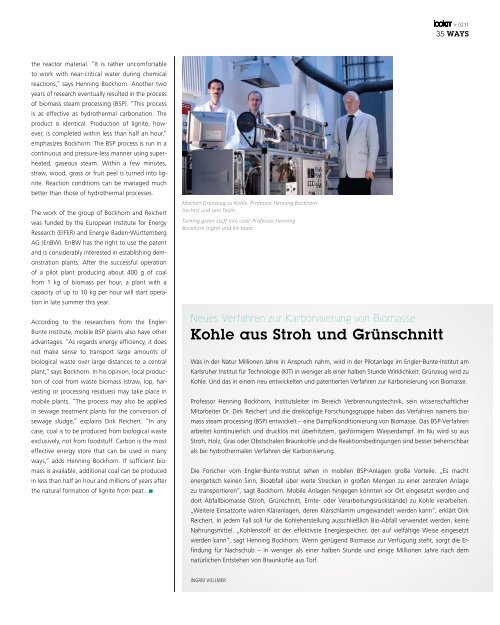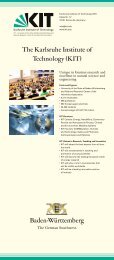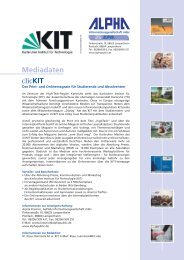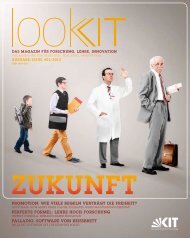lookKIT 02/2011 - PKM - KIT
lookKIT 02/2011 - PKM - KIT
lookKIT 02/2011 - PKM - KIT
Sie wollen auch ein ePaper? Erhöhen Sie die Reichweite Ihrer Titel.
YUMPU macht aus Druck-PDFs automatisch weboptimierte ePaper, die Google liebt.
<strong>02</strong>11<br />
35 Ways<br />
the reactor material. “It is rather uncomfortable<br />
to work with near-critical water during chemical<br />
reactions,” says Henning Bockhorn. Another two<br />
years of research eventually resulted in the process<br />
of biomass steam processing (BSP). “This process<br />
is as effective as hydrothermal carbonation. The<br />
product is identical. Production of lignite, however,<br />
is completed within less than half an hour,”<br />
emphasizes Bockhorn. The BSP process is run in a<br />
continuous and pressure-less manner using superheated,<br />
gaseous steam. Within a few minutes,<br />
straw, wood, grass or fruit peel is turned into lignite.<br />
Reaction conditions can be managed much<br />
better than those of hydrothermal processes.<br />
The work of the group of Bockhorn and Reichert<br />
was funded by the European Institute for Energy<br />
Research (EIFER) and Energie Baden-Württemberg<br />
AG (EnBW). EnBW has the right to use the patent<br />
and is considerably interested in establishing demonstration<br />
plants. After the successful operation<br />
of a pilot plant producing about 400 g of coal<br />
from 1 kg of biomass per hour, a plant with a<br />
capacity of up to 10 kg per hour will start operation<br />
in late summer this year.<br />
According to the researchers from the Engler-<br />
Bunte Institute, mobile BSP plants also have other<br />
advantages. “As regards energy efficiency, it does<br />
not make sense to transport large amounts of<br />
biological waste over large distances to a central<br />
plant,” says Bockhorn. In his opinion, local production<br />
of coal from waste biomass (straw, lop, harvesting<br />
or processing residues) may take place in<br />
mobile plants. “The process may also be applied<br />
in sewage treatment plants for the conversion of<br />
sewage sludge,” explains Dirk Reichert. “In any<br />
case, coal is to be produced from biological waste<br />
exclusively, not from foodstuff. Carbon is the most<br />
effective energy store that can be used in many<br />
ways,” adds Henning Bockhorn. If sufficient biomass<br />
is available, additional coal can be produced<br />
in less than half an hour and millions of years after<br />
the natural formation of lignite from peat.<br />
Machen Grünzeug zu Kohle: Professor Henning Bockhorn<br />
(rechts) und sein Team.<br />
Turning green stuff into coal: Professor Henning<br />
Bockhorn (right) and his team.<br />
Neues Verfahren zur Karbonisierung von Biomasse<br />
Kohle aus Stroh und Grünschnitt<br />
Was in der Natur Millionen Jahre in Anspruch nahm, wird in der Pilotanlage im Engler-Bunte-Institut am<br />
Karlsruher Institut für Technologie (<strong>KIT</strong>) in weniger als einer halben Stunde Wirklichkeit: Grünzeug wird zu<br />
Kohle. Und das in einem neu entwickelten und patentierten Verfahren zur Karbonisierung von Biomasse.<br />
Professor Henning Bockhorn, Institutsleiter im Bereich Verbrennungstechnik, sein wissenschaftlicher<br />
Mitarbeiter Dr. Dirk Reichert und die dreiköpfige Forschungsgruppe haben das Verfahren namens biomass<br />
steam processing (BSP) entwickelt – eine Dampfkonditionierung von Biomasse. Das BSP-Verfahren<br />
arbeitet kontinuierlich und drucklos mit überhitztem, gasförmigem Wasserdampf. Im Nu wird so aus<br />
Stroh, Holz, Gras oder Obstschalen Braunkohle und die Reaktionsbedingungen sind besser beherrschbar<br />
als bei hydrothermalen Verfahren der Karbonisierung.<br />
Die Forscher vom Engler-Bunte-Institut sehen in mobilen BSP-Anlagen große Vorteile. „Es macht<br />
energetisch keinen Sinn, Bioabfall über weite Strecken in großen Mengen zu einer zentralen Anlage<br />
zu transportieren“, sagt Bockhorn. Mobile Anlagen hingegen könnten vor Ort eingesetzt werden und<br />
dort Abfallbiomasse (Stroh, Grünschnitt, Ernte- oder Verarbeitungsrückstände) zu Kohle verarbeiten.<br />
„Weitere Einsatzorte wären Kläranlagen, deren Klärschlamm umgewandelt werden kann“, erklärt Dirk<br />
Reichert. In jedem Fall soll für die Kohleherstellung ausschließlich Bio-Abfall verwendet werden, keine<br />
Nahrungsmittel. „Kohlenstoff ist der effektivste Energiespeicher, der auf vielfältige Weise eingesetzt<br />
werden kann“, sagt Henning Bockhorn. Wenn genügend Biomasse zur Verfügung steht, sorgt die Erfindung<br />
für Nachschub – in weniger als einer halben Stunde und einige Millionen Jahre nach dem<br />
natürlichen Entstehen von Braunkohle aus Torf.<br />
Ingrid Vollmer
















